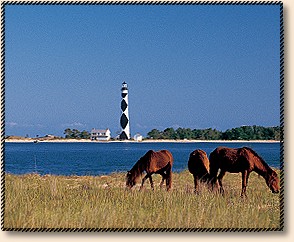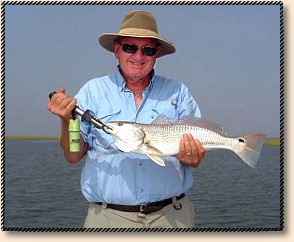The best fishing surprises are those that you least
expect. My favorite fishing area is Middle Marshes
between Beaufort (pronounced "bow-fert") and Shackelford
Banks, near Harker's Island and Cape Lookout. The
wildlife ramp is on Front Street, in Beaufort across
from Carrot Island. This is part of the Outer Bank
chain of barrier islands.
On the Outer Banks of North Carolina, and in the small
villages and towns on the coastal mainland, the oral
histories and traditions handed down generation after
generation are woven with stories of the wild horses
that have lived on the barrier islands for centuries.
From Cape Lookout to Currituck, the elders still say,
"They've always been here; they were here when our
people came; they swam ashore off sinking ships." They
are the Outer Banks wild horses.
In 1493, when Columbus made his second voyage to the
New World, he had with him the numerous items necessary
for colonization, including twenty-five horses. When he
arrived in Hispaniola (between Cuba and Puerto Rico),
his first act was to establish ranches to be run by
the stockmen he had included among his colonists.

They are called banker ponies because they are smaller
horses standing only 14 hands high (a hand is about 4
inches, measured from the shoulder to the ground).
Years ago, the folks on the Outer Banks started calling
them Banker ponies and the name stuck. Ok, what does
this have to do with fishing. It is the location of
this great fishing spot and the constant contact you
will have with these ponies...that's what makes it so great!
The Middle Marshes cover a central location between
four channels running from behind Carrot Island to
the backside of Shackelford Banks. Carrot Island
flanks the southeast side of Taylor's Creek where
the Wildlife ramp is located. This is a large area
of flats with small, low lying grassy islands of
shallow water consisting of a hard bottom and oysters.
The tide runs fast and digs deep into the grassy edges.
It carries a lot of bait and the puppy drum can be thick.
I picked up Lee Padgett and Phil Gerolstein at the ramp
and we motored down Taylor's Creek. A large menhaden
plant is a sore spot on the north side of the creek.
The menhaden plant is slated for demolition. I don't
think anyone will object.
Lee and Phil were using 8wt fly rods. Both were using
St. Croix Ultra Legends. Both were rigged with wet tip
clear lines and both had 12-pound leaders. We rounded
the bouys by the east end of Carrot Island. There not
35 feet away were four Bankers and a foal. What a cool
picture with them and the lighthouse as a backdrop.
They were standing on the waters edge and just watching
all the boats going and coming through the cut. My
anglers were just in awe as we motored by these beautiful
ponies.
"Do they ever bother anglers?" Phil asked.
"No," I said, "But remember these are wild horses."
I took the channel towards Harkers and Cape Lookout.
My favorite approach is the north east side of Middle
Marshes. There is a hook and a small bank that helps
to block the southeasterly winds that blow up from
Beaufort Inlet. The key to catching puppy drum here
is to arrive an hour before high tide. I find the best
catching time just at the end of the slack and the tide
starts to fall. If you aren't in a flats boat, best to
pay attention to the water level, least you get caught
high and dry.
I polled around two cuts and an oyster bed. Lee got
on the platform and started casting to the grass line
and nearby oyster beds. Bait was moving in balled up
pods. The water was gin clear to the bottom in about
two to three feet of water. We used a gold/pink
copperhead tied on a #2 owner Fly-liner hook. This is
basically a Clouser Minnow with a lot of flash and hot
pink estaz. The fly is fished in a hopping motion.
It wasn't long before Lee had a solid hit. But like many
fly anglers, he got excited and pulled the fly from the
puppy drum's mouth. We moved back to the edge of a drop
off and he recast so the fly would be carried into the
slough by the tide. This time he let the puppy drum
gobble the fly.
I thought Lee would lose his fly rod. This puppy drum ran
to the opposite bank and then made a run at the boat.
In a rush to get his fly out of the water Phil snagged
an oyster shell and was hung on the bottom. Meantime
Lee was running around the boat like Sambo chasing the
Tiger. The puppy drum didn't make any long runs but
he was wearing Lee out moving back and forth from one
side of the boat to the other.
Meantime Phil was worried about his line, since we had
drifted some distance from where he got hung up and was
already into his backing. I got off the poling platform
and started the trolling motors. Well…wouldn't you know
that puppy drum kicked into 6th gear and started racing
up a cut. Since Lee wasn't into his backing, we let him
run (think it was a he), while I motored us over to wear
Phil was hung up. Because of our position we easily
freed Phil's line and he reeled in.
"Lee...Try to turn him."
I wanted that fish to turn back towards the boat. The
tide was really running out now and the puppy drum was
running the wrong way for us. Finally, he turned and
started right at the boat. Lee was now leaning on the
poling platform. I motored as fast as we could towards
the deep side of a cut to get out of the marsh and back
into the sound. Then I ran into the bank. We were stuck
for about 2 minutes, but it felt like hours. The tide
was pushing us hard. If I could get us free we would
float right over to Harker's Island and deeper water.
 An hour had gone by. Lee was sweating, tired and
generally whipped. We finally cleared the marsh with
Lee's fish following right behind. We got this guy to
the boat, took pictures, but this time he was going home
with Lee for dinner. This is pretty typical of the
puppy drum (about 24 inches) for this area. These
puppy drum are about 3 years old. We'll probably
have another season with them before they move out
into the ocean. ~ Doug
An hour had gone by. Lee was sweating, tired and
generally whipped. We finally cleared the marsh with
Lee's fish following right behind. We got this guy to
the boat, took pictures, but this time he was going home
with Lee for dinner. This is pretty typical of the
puppy drum (about 24 inches) for this area. These
puppy drum are about 3 years old. We'll probably
have another season with them before they move out
into the ocean. ~ Doug
About Doug:
Capt Doug Sinclair is a saltwater fly-fishing guide,
casting instructor, writer and photographer from Alliance
(Oriental), North Carolina. You can find him on the web
at www.flyfishcarolina.com or call him at 252.617.5580.
|


 An hour had gone by. Lee was sweating, tired and
generally whipped. We finally cleared the marsh with
Lee's fish following right behind. We got this guy to
the boat, took pictures, but this time he was going home
with Lee for dinner. This is pretty typical of the
puppy drum (about 24 inches) for this area. These
puppy drum are about 3 years old. We'll probably
have another season with them before they move out
into the ocean. ~ Doug
An hour had gone by. Lee was sweating, tired and
generally whipped. We finally cleared the marsh with
Lee's fish following right behind. We got this guy to
the boat, took pictures, but this time he was going home
with Lee for dinner. This is pretty typical of the
puppy drum (about 24 inches) for this area. These
puppy drum are about 3 years old. We'll probably
have another season with them before they move out
into the ocean. ~ Doug